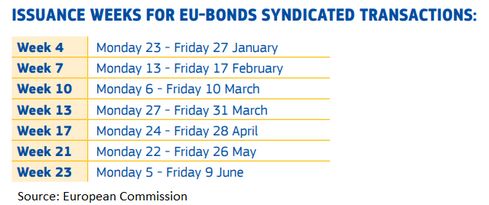The European Union has announced it will fund €80bn in the first half of 2023 alone. The ambitious goal is set for a year that already promises huge public sector borrowing, even as inflation and volatility remain high.
The €80bn sum is a goal that the EU has previously targeted for a whole 12 months.
The EU has been able to drum up strong bids in recent months, paying attractive spreads as it contends with balancing the scale of its funding needs against more demanding buyers. As inflation bumps up yields, investors have upped their expectations of returns.
As well as paying up to clear bonds, the EU is changing how it markets its appearances.
The supra has scrapped the separate branding it has used to fund its various funding programmes (for example Next Generation EU, known as NGEU) and plans to use an all-encompassing “EU-Bond” label. The EU envisions taking the proceeds from the new single-brand bonds and allocating them as needed to the NGEU scheme and the Macrofinancial Assistance (MFA) programme for Ukraine.
Prior to the single-brand approach, the EU had marketed each of its bonds with labels denoting which programmes the funds would be used for. Often the bonds would include more than one label, like combined NGEU and MFA outings, or different bonds in the same dual-tranche offering would be headed for different schemes.
There had previously been concerns that the EU’s different funding schemes were adding an additional level of complexity to the EU’s outings for investors, though that talk has not materialised into any recent ill-performance in the primary market.
A big exception is in green bonds. The EU will still issue NGEU green products, the supra said in its funding plan. Smaller deals for the MFA programme will also still be marketed separately.
The EU is planning seven syndications and eight auctions in the first six months of 2023. The first window for a benchmark is the last full week of January. Tenors will be “across the yield curve, subject to market conditions”.

Auctions will play a greater role in the EU’s 2023 funding, the plan read, to “achieve greater liquidity”.
Big plans
The EU is not the only name looking to issue a significant sum in 2023. KfW is targeting €80bn-€85bn over the course of 2023 via the capital markets, only a touch less than the record €90bn it raised in the last 12 months.
"2023 will certainly be another challenging year,” said KfW treasurer Tim Armbruster in a statement, “especially since, in addition to the expected volatility, a lot of issue activity can be expected". Armbruster is expecting a “very active first quarter”, the announcement for the issuer’s 2023 plan read. The news that the ECB will reduce its APP holdings from March 2023 onwards is going to exacerbate that dynamic, the KfW’s announcement read.
The name is keeping its green pipeline steady, planning €10bn in green issuance in 2023, following the €10.6bn it issued in the last 12 months. It is planning at least one big euro green bond and will offer more in other core currencies depending on conditions.
Like this year, most of KfW’s funding is going to come via euro and US dollars, the announcement read. KfW is aiming for at least one dollar benchmark per quarter in 2023 given that market's “strategic importance”.
KfW will be hoping 2023 is less tumultuous than 2022 proved to be. Its record funding programme was executed as the war in Ukraine broke out, the associated energy crisis hit, and high inflation struck for the first time in decades.
Like the EU, that meant paying higher premiums for access to cash.
“[T]he second half of the year was once again strongly characterised by uncertainty, in particular with regard to double-digit inflation rates; capital market investors therefore demanded significantly higher risk premiums,” KfW’s announcement read, though the issuer noted that it had raised around two-thirds of its planned funding in the first half of the year.